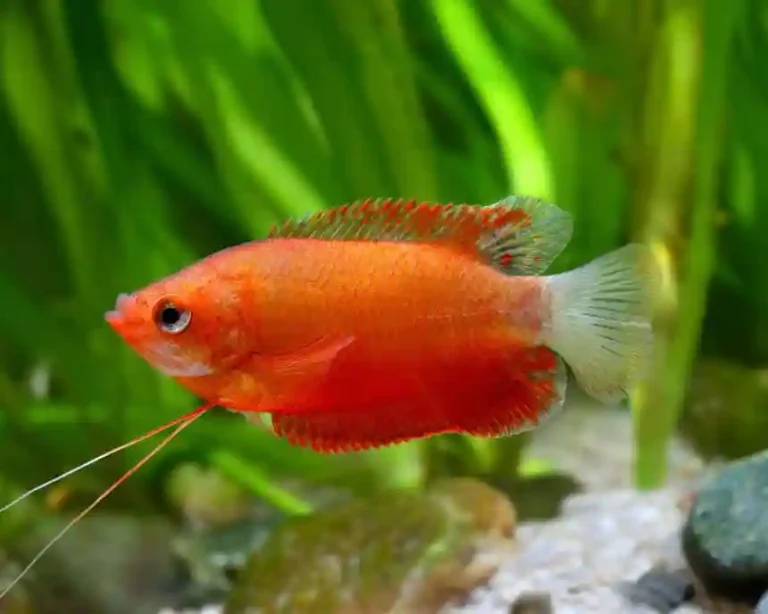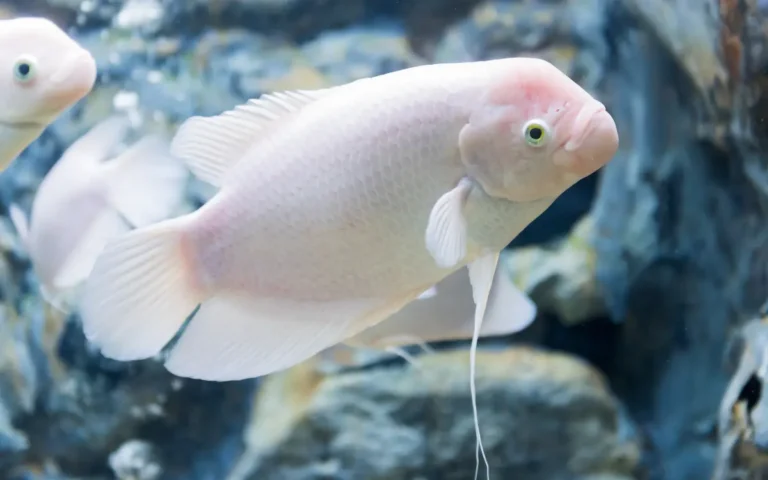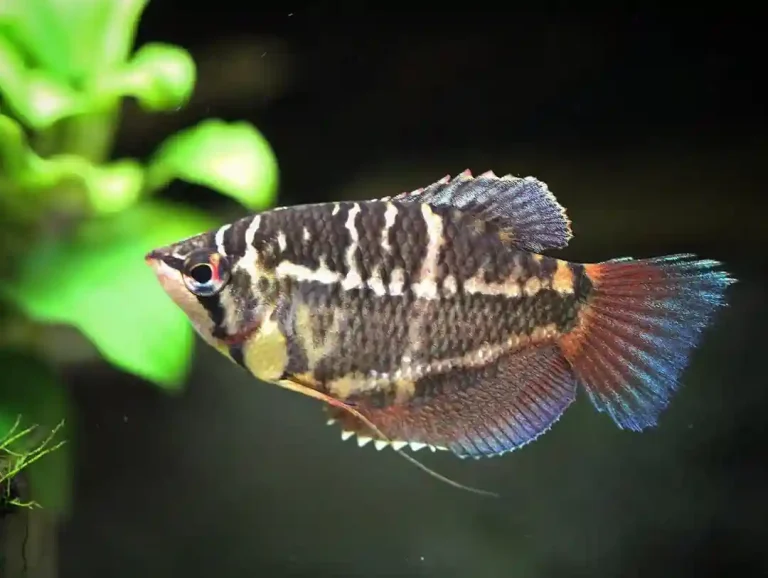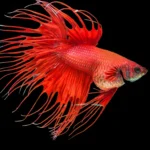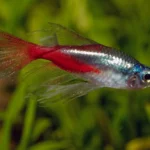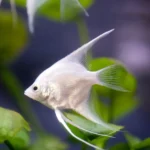Plecos are some of the most fascinating fish you can add to your freshwater aquarium. These algae-eating catfish not only help keep your tank clean but also add character with their unique appearances and behaviors. With hundreds of species available in the aquarium trade, choosing the right pleco can be overwhelming for both beginners and experienced fish keepers.
In this comprehensive guide, we’ll explore the 10 most popular types of plecos, their specific care requirements, and how to help them thrive in your aquarium.
What Are Plecos?
Plecos, short for Plecostomus, belong to the Loricariidae family of armored catfish. Native to South American waterways, these bottom-dwellers have adapted to various environments, from fast-flowing rivers to calm, murky waters. Their distinctive sucker-like mouths allow them to attach to surfaces and scrape off algae, earning them the nickname “sucker fish.”
With over 680 species across more than 90 genera, plecos come in countless shapes, sizes, and colors. Many newer species are identified by “L-numbers” rather than scientific names, making it easier to distinguish between similar-looking fish in the aquarium trade.
Now, let’s dive into the 10 most popular pleco species for home aquariums!
1. Common Pleco (Hypostomus plecostomus)
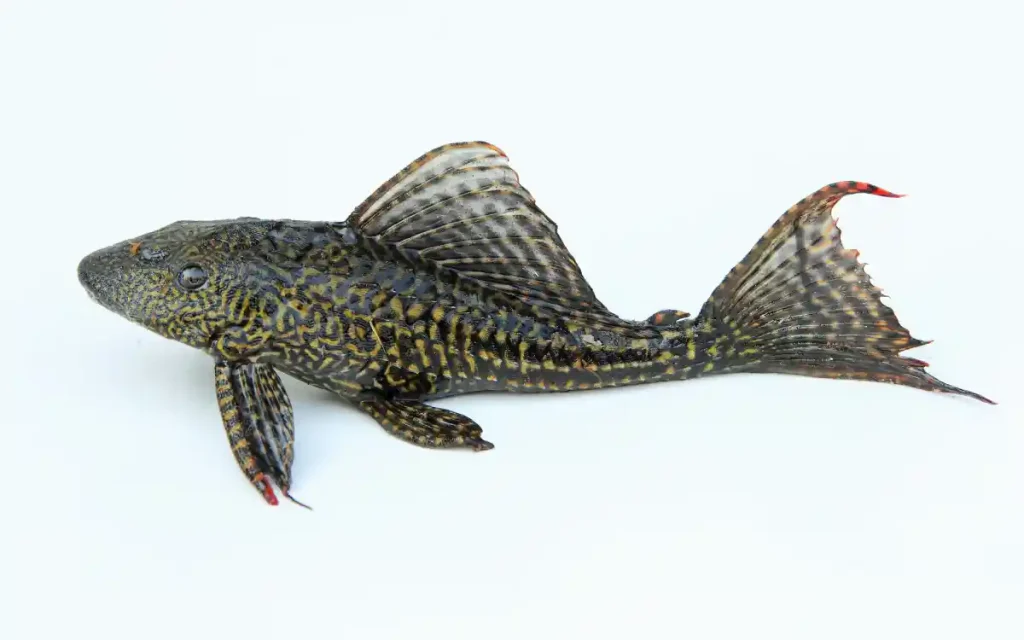
The Common Pleco is often the first species that comes to mind when people think of these fish. It’s widely available in pet stores and has been a staple in the aquarium hobby for decades.
Size and Appearance
- Grows up to 15-24 inches (38-60 cm) in captivity
- Brown to gray body with dark spots
- Armored plates covering the body
- Large, powerful sucker mouth
Care Requirements
- Tank Size: Minimum 75 gallons for juveniles, 125+ gallons for adults
- Diet: Omnivorous – algae, vegetables (zucchini, cucumber), sinking pellets, driftwood
- Water Parameters: Temperature 74-80°F (23-27°C), pH 6.5-7.5
- Lifespan: 10-15 years with proper care
Pros and Cons
| Pros | Cons |
| Excellent algae eater | Grows extremely large |
| Hardy and disease-resistant | Produces significant waste |
| Affordable and widely available | Can be territorial as it matures |
| Long lifespan | Needs very large tank |
Best For: Large aquariums with ample filtration and space. Not recommended for beginners or those with smaller tanks.
2. Bristlenose Pleco (Ancistrus sp.)
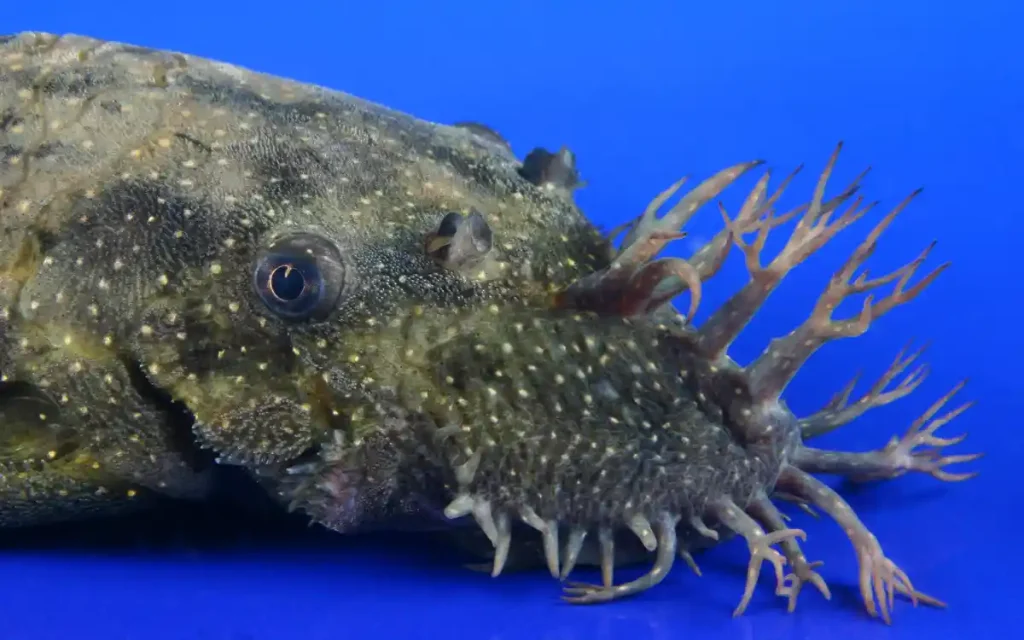
The Bristlenose Pleco is arguably the most popular species for home aquariums due to its manageable size and efficient algae-eating habits. Males develop distinctive fleshy tentacles on their snouts, giving them their common name.
Size and Appearance
- Grows to 4-6 inches (10-15 cm)
- Brown to black body, sometimes with spots
- Males have prominent bristles on their snouts
- Several color varieties available (albino, super red, long-fin)
Care Requirements
- Tank Size: Minimum 20-30 gallons
- Diet: Primarily herbivorous – algae, vegetables, algae wafers, some wood
- Water Parameters: Temperature 60-80°F (15-27°C), pH 6.0-7.5
- Lifespan: 5-12 years
Pros and Cons
| Pros | Cons |
| Stays small | Less effective against certain algae types |
| Excellent algae eater | Can be territorial with other plecos |
| Adaptable to various water conditions | Needs hiding places |
| Breeds readily in home aquariums | Males may fight for territory |
Best For: Community tanks, planted aquariums, beginners. The perfect “starter pleco” for most aquarists.
3. Clown Pleco (Panaque maccus)
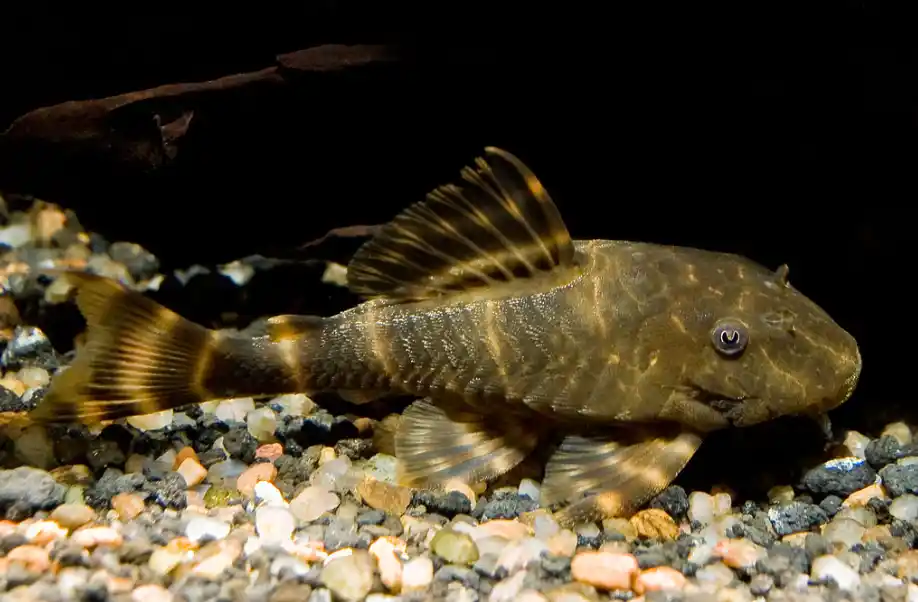
The Clown Pleco is a small, attractive species known for its striking pattern of light and dark stripes or bands. Unlike many plecos, they’re known for their wood-eating habits.
Size and Appearance
- Grows to 3-4 inches (7-10 cm)
- Black body with bright yellow or cream stripes/bands
- Compact, rounded body shape
Care Requirements
- Tank Size: Minimum 20 gallons
- Diet: Primarily lignivorous (wood-eating) – requires driftwood, also enjoys vegetables and algae wafers
- Water Parameters: Temperature 73-82°F (23-28°C), pH 6.0-7.0
- Lifespan: 10-12 years
Pros and Cons
| Pros | Cons |
| Stays very small | Not as efficient at algae removal |
| Beautiful patterning | Requires driftwood in diet |
| Peaceful temperament | Can be shy and reclusive |
| Long lifespan | Prefers specialized conditions |
Best For: Smaller community tanks, aquascapes focused on driftwood, those wanting a less common pleco species.
4. Zebra Pleco (Hypancistrus zebra)
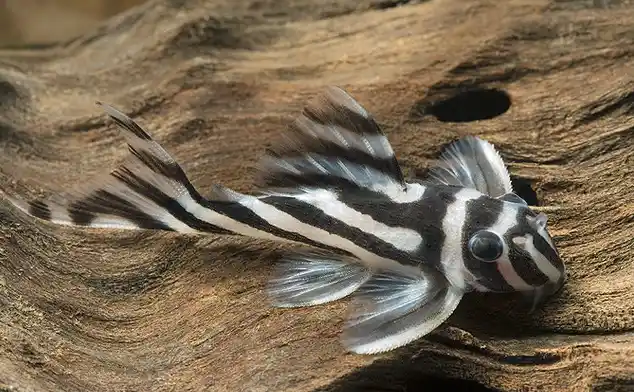
The Zebra Pleco is one of the most sought-after species in the hobby due to its striking black and white striped pattern. Originally from the Xingu River in Brazil, these fish are now primarily captive-bred.
Size and Appearance
- Grows to 3-4 inches (7-10 cm)
- Dramatic black and white zebra-striped pattern
- Compact body with large fins
Care Requirements
- Tank Size: Minimum 20-30 gallons
- Diet: Primarily carnivorous – bloodworms, brine shrimp, high-quality pellets, some vegetables
- Water Parameters: Temperature 78-86°F (26-30°C), pH 6.5-7.0, needs good water flow
- Lifespan: 10-15 years
Pros and Cons
| Pros | Cons |
| Spectacular appearance | Very expensive ($100-300+ each) |
| Stays small | More sensitive to water conditions |
| Peaceful temperament | Doesn’t eat much algae |
| Can breed in captivity | Requires specialized care |
Best For: Experienced aquarists, dedicated species tanks, those willing to invest in premium livestock.
5. Gold Nugget Pleco (Baryancistrus xanthellus)

Gold Nugget Plecos are striking fish with dark bodies covered in bright yellow spots, resembling gold nuggets. Their bright yellow fin edging makes them stand out in any aquarium.
Size and Appearance
- Grows to 7-10 inches (18-25 cm)
- Black body with yellow to gold spots
- Yellow edging on fins
- Several varieties with different spot patterns
Care Requirements
- Tank Size: Minimum 55-75 gallons
- Diet: Omnivorous – algae, vegetables, sinking pellets, some meaty foods
- Water Parameters: Temperature 76-84°F (24-29°C), pH 6.0-7.5, needs high oxygen and water movement
- Lifespan: 10-15 years
Pros and Cons
| Pros | Cons |
| Stunning appearance | Moderately expensive |
| Good algae eater | Grows fairly large |
| Active personality | Needs strong water flow |
| Hardy once established | Can be territorial |
Best For: Medium to large community tanks with good filtration and water movement.
6. Royal Pleco (Panaque nigrolineatus)
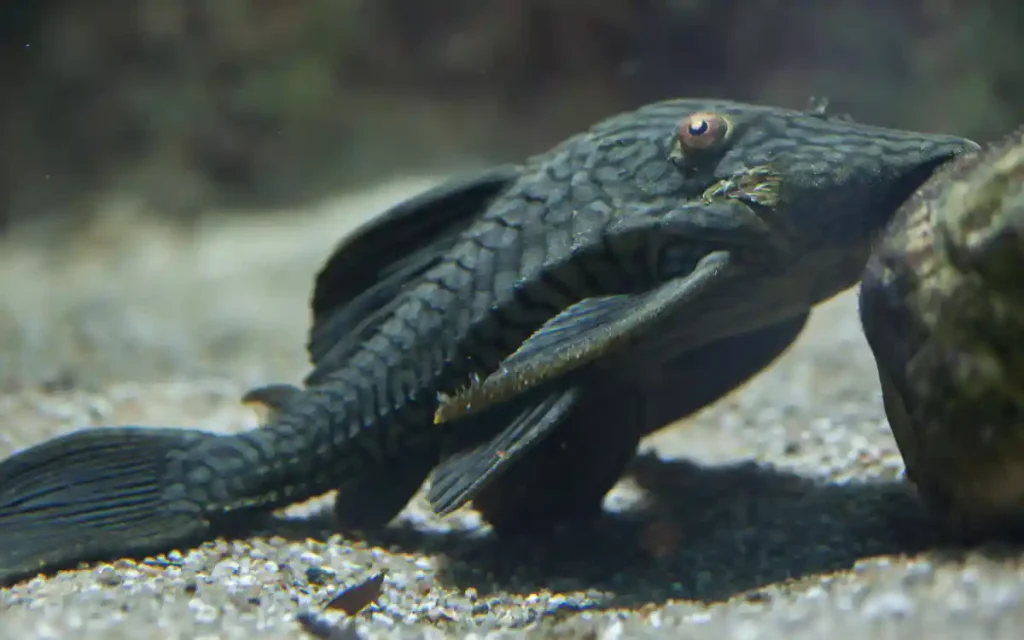
The Royal Pleco, also known as the Royal Panaque, is a large, impressive wood-eating species. With its distinctive green and black pattern, it makes a dramatic centerpiece in larger aquariums.
Size and Appearance
- Grows to 13-17 inches (33-43 cm)
- Dark body with light green to white stripes
- Armored body with powerful sucker mouth
- Large teeth specialized for rasping wood
Care Requirements
- Tank Size: Minimum 125 gallons
- Diet: Lignivorous – requires driftwood, also needs vegetables and sinking pellets
- Water Parameters: Temperature 74-82°F (23-28°C), pH 6.5-7.5
- Lifespan: 15-20+ years
Pros and Cons
| Pros | Cons |
| Impressive, unique appearance | Grows very large |
| Interesting wood-eating behavior | Produces substantial waste |
| Very long lifespan | Requires very large tank |
| Peaceful despite size | Expensive to purchase and maintain |
Best For: Large aquariums and dedicated enthusiasts who can commit to decades of care.
7. Snowball Pleco (Hypancistrus inspector) – L102
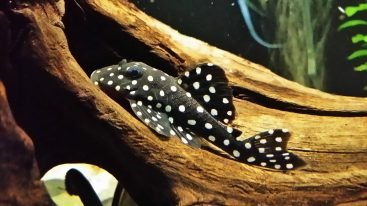
The Snowball Pleco features a striking pattern of white dots on a dark background, resembling snowballs or stars against a night sky. This medium-sized species is less common but highly desirable.
Size and Appearance
- Grows to 5-6 inches (12-15 cm)
- Black body covered with round white spots
- Spots may merge as fish ages
Care Requirements
- Tank Size: Minimum 30-40 gallons
- Diet: Omnivorous – meaty foods, quality pellets, some vegetables
- Water Parameters: Temperature 77-84°F (25-29°C), pH 6.0-7.0
- Lifespan: 8-10 years
Pros and Cons
| Pros | Cons |
| Beautiful spotting pattern | Moderately expensive |
| Manageable size | Not an effective algae eater |
| Generally peaceful | Can be shy and reclusive |
| Less common in the hobby | Prefers specialized diet |
Best For: Experienced aquarists looking for something different, community tanks with hiding spots and caves.
8. Rubber Lip Pleco (Chaetostoma milesi)
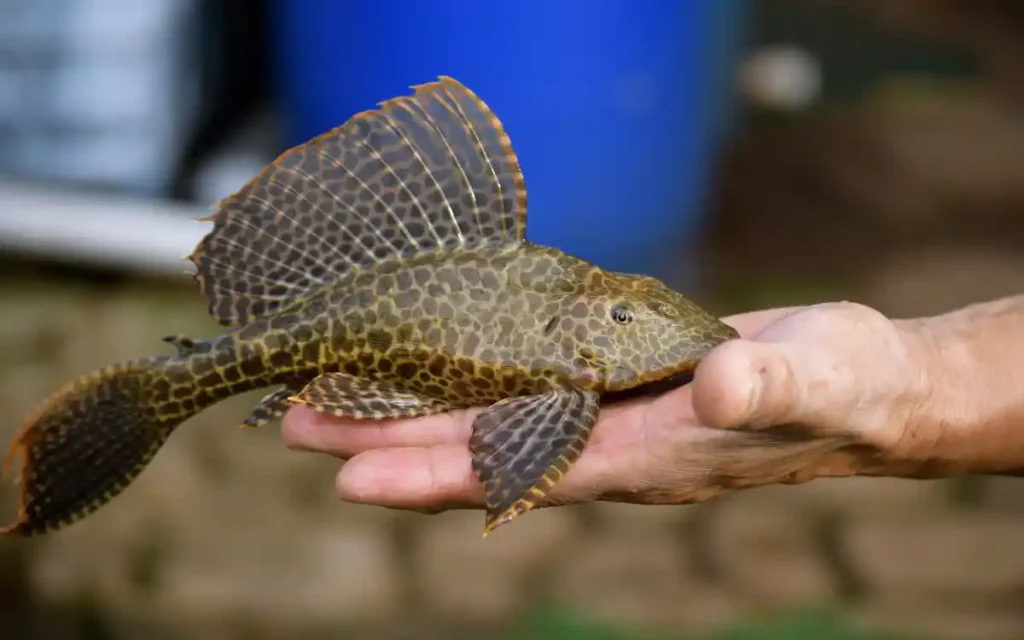
The Rubber Lip Pleco gets its name from its distinctive rubbery lips, which are perfectly adapted for scraping algae. This medium-sized species is known for being one of the most effective algae eaters.
Size and Appearance
- Grows to 6-7 inches (15-18 cm)
- Gray to brown body with a speckled pattern
- Distinctive fleshy lips
- Flatter body profile than many plecos
Care Requirements
- Tank Size: Minimum 30 gallons
- Diet: Primarily herbivorous – algae, vegetables, algae wafers
- Water Parameters: Temperature 72-79°F (22-26°C), pH 6.5-7.5, prefers cooler water
- Lifespan: 10-12 years
Pros and Cons
| Pros | Cons |
| Excellent algae eater | Less colorful than other species |
| Stays moderately sized | Can be territorial with other plecos |
| Tolerates cooler water | Needs supplemental feeding |
| Active during daytime | Sensitive to high temperatures |
Best For: Planted community tanks needing algae control, tanks that run on the cooler side.
9. Starlight Bristlenose Pleco (Ancistrus dolichopterus)

The Starlight Bristlenose combines the manageable size of bristlenose plecos with a beautiful pattern of white dots resembling stars in the night sky. Males develop the characteristic bristles on their snouts.
Size and Appearance
- Grows to 4-5 inches (10-13 cm)
- Dark body with small white spots
- Males develop bristles on snout
Care Requirements
- Tank Size: Minimum 20-30 gallons
- Diet: Herbivorous – algae, vegetables, algae wafers, some wood
- Water Parameters: Temperature 73-82°F (23-28°C), pH 6.0-7.5
- Lifespan: 5-8 years
Pros and Cons
| Pros | Cons |
| Beautiful starry pattern | More expensive than common bristlenose |
| Stays small | Spots may fade as fish ages |
| Good algae eater | Males can be territorial |
| Breeds in captivity | Requires hiding places |
Best For: Community tanks, planted aquariums, those who want a bristlenose with more visual appeal.
10. King Tiger Pleco (Hypancistrus sp.)
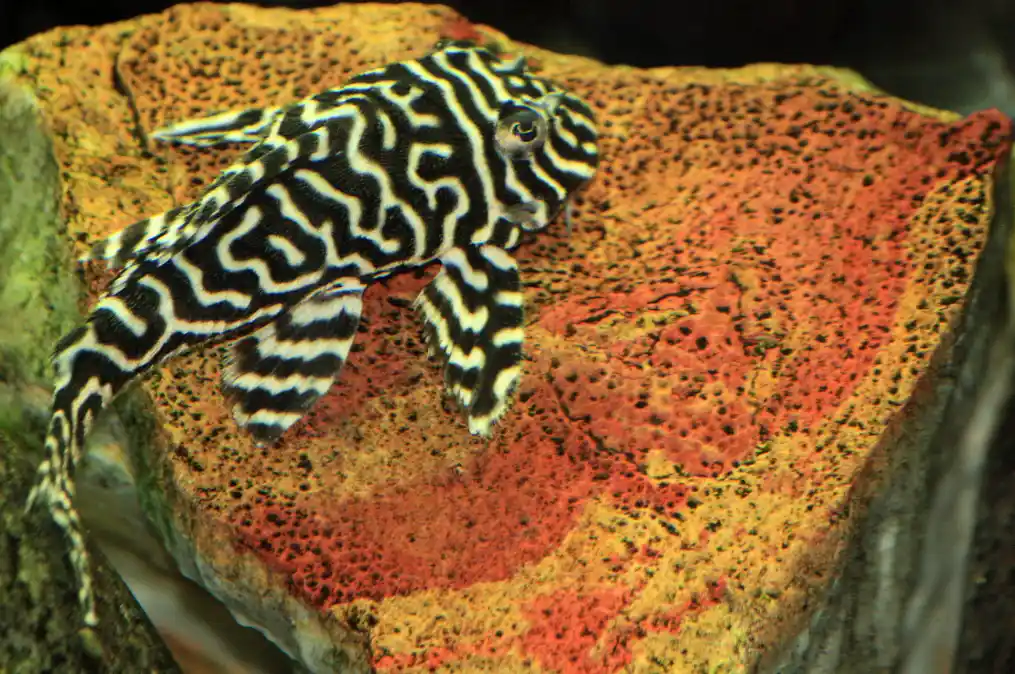
The King Tiger Pleco features striking tiger-like stripes across its body. This medium-sized species makes a beautiful addition to community tanks while remaining a manageable size.
Size and Appearance
- Grows to 5-6 inches (12-15 cm)
- Light body with dark tiger-striped pattern
- Pattern may change as fish matures
Care Requirements
- Tank Size: Minimum 30-40 gallons
- Diet: Omnivorous – meaty foods, quality pellets, some vegetables
- Water Parameters: Temperature 77-86°F (25-30°C), pH 6.0-7.0
- Lifespan: 10-15 years
Pros and Cons
| Pros | Cons |
| Beautiful tiger striping | Moderately expensive |
| Manageable size | Not an effective algae eater |
| Generally peaceful | Can be shy and reclusive |
| Long lifespan | Prefers specialized diet |
Best For: Community tanks with caves and hiding places, moderately experienced aquarists.
Understanding L-Numbers in Plecos
If you’ve been shopping for plecos, you’ve likely seen codes like “L046” or “L333” alongside fish names. These “L-numbers” (with L standing for Loricariidae) were developed by the German aquarium magazine DATZ to identify newly discovered species before they received scientific names.
Today, L-numbers remain a valuable identification system in the hobby, especially for rarer species. When purchasing plecos, knowing the L-number can help ensure you’re getting the exact species you want, as common names can sometimes be applied to multiple species.
Essential Pleco Care Tips
No matter which pleco species you choose, these general care guidelines will help your catfish thrive:
Housing Requirements
- Tank Size: Always size your tank for the adult size of your pleco, not its juvenile size
- Hiding Places: Provide caves, driftwood, and other structures for security
- Substrate: Smooth sand or rounded gravel to protect their undersides
- Filtration: Strong filtration to handle their bioload and maintain water quality
- Water Flow: Most species appreciate moderate to strong water movement
Feeding Your Pleco Properly
Food Types:
- Algae wafers (staple for herbivorous species)
- Blanched vegetables (zucchini, cucumber, spinach, sweet potato)
- Driftwood (essential for wood-eating species)
- High-quality sinking pellets
- Frozen foods for carnivorous species (bloodworms, brine shrimp)
Feeding Schedule:
- Feed daily for smaller species
- Feed every other day for larger species
- Target feed at night when most plecos are active
Common Health Issues and Solutions
| Problem | Symptoms | Solution |
| Poor water quality | Lethargy, loss of appetite, rapid gill movement | Increase water changes, improve filtration |
| Ich (white spot disease) | White spots on body, scratching against objects | Raise temperature gradually, use appropriate medication |
| Nutritional deficiencies | Faded colors, weight loss, curved spine | Diversify diet, ensure proper nutrition |
| Aggression from tank mates | Damaged fins, hiding excessively | Rearrange decor, separate aggressive fish |
FAQ’s
Q: How do I know if my pleco is male or female?
A: In many species, males develop more pronounced odontodes (bristles or spines) on their heads or pectoral fins. In bristlenose plecos, males have distinctive bristles on their snouts, while females have few or none.
Q: Why is my pleco always hiding?
A: This is normal behavior – plecos are naturally nocturnal. Provide plenty of hiding spots and observe your fish in the evening with dim lighting.
Q: Do plecos need special food, or will they just eat algae?
A: While many plecos eat algae, they all need supplemental feeding. Algae alone is insufficient nutrition. Provide species-appropriate food as outlined in this guide.
Q: Can different pleco species live together?
A: With sufficient space and hiding places, some species can coexist. However, similar-looking species may become territorial with each other. Research specific compatibility before combining plecos.
Q: How often should I clean my tank with a pleco in it?
A: Plecos produce significant waste – perform 25-30% water changes weekly, with more frequent changes for larger species or smaller tanks.
Final Thoughts
Plecos are fascinating fish that combine utility with unique personality and appearance. By choosing the right species for your tank size and setup, you’ll enjoy years of companionship from these remarkable catfish.
Remember that the smallest plecos (Bristlenose, Clown, and Zebra) are usually best for typical home aquariums, while larger species require substantial tanks and long-term commitment.
Whether you’re drawn to the practicality of an algae-eating bristlenose or the striking beauty of a zebra pleco, these fish make wonderful additions to properly sized community tanks.

